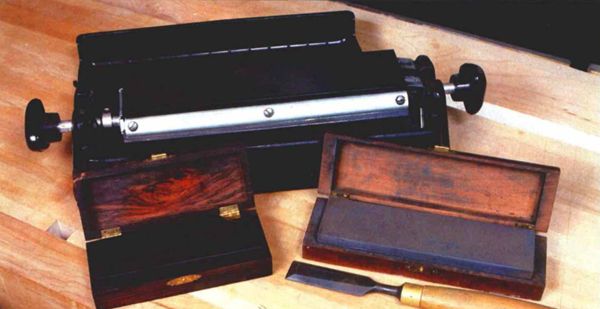
Synopsis: Michael S. Podmaniczky discusses the steps necessary to take a chisel or plane iron from dull to sharp: establishing the bevel on the bench grinder, and sharpening on the various stones, from coarse to fine. He defines what he means by sharp and tells why he prefers oilstones to waterstones. He explains how to grind a tool, settle it properly in the tool rest as you’re grinding, and why it doesn’t pay to grind to a featheredge. He compares his sharpening method to others he’s seen and describes how to do it. Side information talks about how and why to grind the other side of the edge: the back.
There are legions of would-be woodworkers who think that the edge that their new chisel arrives with is forever. I know because I’ve met some of them. But charity and understanding are needed rather than contempt; after all, I hate to think what I will do the first time I have a masons’ trowel in hand, or at which end of the cobblers’ bench I would sit down. No, this sort of thing is not at all inherent and must be learned like everything else.
In fact, without a good grounding in sharpening procedures, nothing else that follows can be properly done, and that includes, well, everything. I hate to think how many beautiful projects have been discouraged because the tools just didn’t perform as expected. Sharpening is so important that it must eventually become second nature to the wood craftsman. We will discuss the various steps necessary to take a chisel or plane iron from dull to sharp: establishing the bevel on the bench grinder and sharpening on the various stones, from coarse to fine. While this is a step-by-step procedure, I hope that in due time those steps will blend together in your subconscious so that there will be no more thinking, only doing.
Before doing, however, must come knowing. What exactly does “sharp” mean? We know the ideal, a perfect wedge of steel, tapering down to microscopic nothingness. Unfortunately, whether in foreign policy or tool handling, ideals are easier to imagine than to attain. When steel is pushed across even the finest stone, bits of metal are worn away and microscopic serrations are formed on the edge—these correspond in dimension to the grit of the stone. What we try to do is minimize the size of the serrations and maximize their regularity.
Most edge tools are pushed through the wood, and consequently require the finest serrations so as not to drag on the wood fibers. For this, a progression of stones is used, ending with the finest grit possible. A knife, drawknife, or other tool that is used in a slicing motion, such as (forgive me) a steak knife, works best with slightly greater, but still regular serrations on the edge. In this case, the progression through stone grits can stop short of the finest. Our task is to be able to consistently produce the edge we need for the best woodwork possible.
From Fine Woodworking #61
For the full article, download the PDF below:
Fine Woodworking Recommended Products

Tite-Mark Marking Gauge

Marking knife: Hock Double-Bevel Violin Knife, 3/4 in.

Veritas Precision Square






















Log in or create an account to post a comment.
Sign up Log in